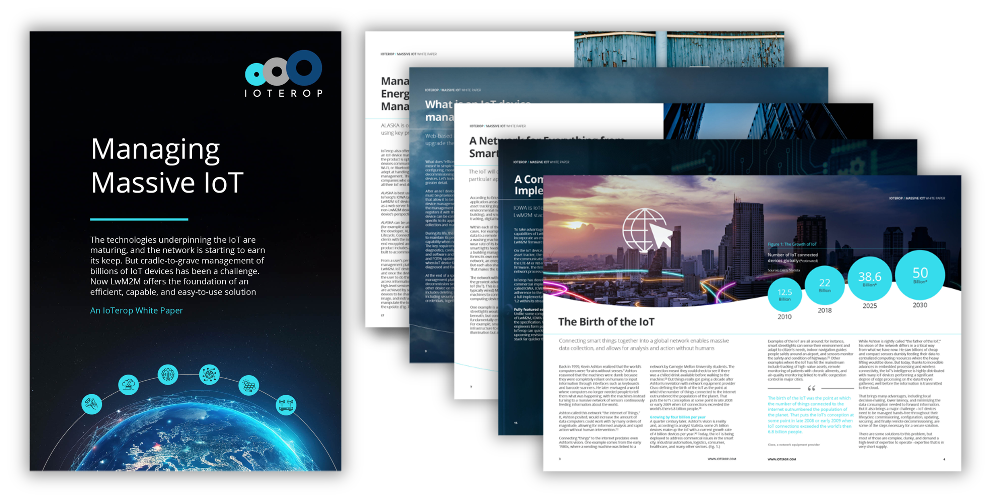Why Do We Need Massive IoT Device Management?
Supervision and control of millions of IoT devices will be critical if we are to realize the promise of a smart future
If you are a utilities manager, smart city solutions provider, asset tracking company decision-maker or a stakeholder in any number of burgeoning IoT industries, how you manage your smart devices will be directly linked to the growth and success of your organization. That’s how important device management is and why it’s vital to get it right. But before we can fully appreciate why this is the case, we must consider the rise of “massive IoT” and what it means for a variety of verticals.
Massive IoT refers to a technology that sees an operational density of millions of IoT devices per square kilometer. In this vision of the future, smart device networks will cover vast expanses—even entire cities or countries—underpinning applications that make the world smarter, safer and better. Examples include sectors like smart meters, smart streetlights, and cargo asset trackers.
Massive IoT promises excellent opportunities for such organizations to improve their services and save resources. For example, the data from remote sensors can enable big reductions in routine visits to remote sites by quickly identifying the precise locations where problems need addressing, saving time and money. This is just one example of thousands.
A 2017 Cisco survey of IT and business decision-makers working for organizations that were implementing or had completed IoT initiatives in the U.S., U.K., and India across a range of industries—including manufacturing, government, retail, hospitality, energy, transportation and healthcare—found that 73 percent of all participants were using data from IoT completed projects to improve their business, with improved profitability the main unexpected benefit at 39 percent. But to realize this future, we must first address some key challenges.
Why do IoT Projects Fail?
Few would argue the rapidly developing IoT market offers enormous potential for doing things smarter and more efficiently. But the reality is too many individual IoT projects are still not meeting expectations; or worse, they are failing entirely.
An extensive 2023 study of IoT adopters by technology research and analysis firm, Beecham Research, shows that almost a quarter (24 percent) of IoT projects have been considered mostly unsuccessful or not successful, while only 16 percent of IoT projects have been considered fully successful.
On the positive side, this represents a marked improvement on the firm’s findings from three years earlier, when an alarming 58 percent of IoT projects were considered mostly unsuccessful or not successful.
Elsewhere, a Microsoft report based on research conducted by industry analyst, IoT Analytics, suggests that IoT projects in 2023 have a 14 percent higher success rate than five years ago.
Although success rates are clearly on the rise, there remains plenty of room for improvement. So, why do IoT projects fail? Across thousands of projects, Beecham Research identified several consistent challenges – one of which related to unforeseen technological problems.
High-performance, low-latency network connectivity enabling reliable data transfer is generally the cornerstone of a successful IoT project. Despite this, not all wireless networks are designed with the IoT and rapid scalability in mind. Growing from a relatively small number of devices on a “plug and play” network up to hundreds of thousands or even millions of sensors is a task that should not be taken lightly. And when the complexity involved in deploying connectivity at scale is underestimated, IoT projects can quickly become far more challenging than anticipated.
Once properly implemented, the IoT has proven able to deliver enormous operational and service benefits to businesses of different sizes across many sectors. Yet the current high rate of project failure indicates that proper implementation is tough and there’s much that can go wrong.
What’s the Solution?
Cellular IoT—technology based on international standards, and which uses established cellular network infrastructure—is the answer to the IoT network requirements outlined in the Beecham Research report. Cellular IoT is a low power wide area network (LPWAN) that provides a proven means to transfer vital data from sensors to the cloud wirelessly, reliably, and securely across kilometer distances. Once in the cloud these huge volumes of data can be analyzed and used for automated decision making.
But cellular IoT on its own is not enough. Beyond a reliable LPWAN technology, what massive IoT needs for effective deployment and maintenance is device management. This device management needs to rapidly scale, and make things not only simple for engineers, but for everyone.
Good device management technology enables large numbers of IoT devices to be commissioned, configured, monitored, maintained, and secured. Without it, operational requirements such as essential software updates or decommissioning at the end of a smart device’s life can become a nightmare.
While the cellular IoT technology, NB-IoT, does include mechanisms to perform some of these functions, they require expertise to use, are clunky, and hardly user-friendly. Lightweight M2M (LwM2M) is a much better solution. It works seamlessly with cellular IoT and is purpose-built for the IoT device management of resource-constrained IoT end-devices and energy-efficient applications (although it is equally capable of supporting more sophisticated IoT devices).
IoTerop has developed an optimized and streamlined LwM2M stack compatible with all versions of the open standard upon which LwM2M is based. Called IOWA, the software opens a “service tunnel” to all your IoT devices, making it quick and easy to commission, configure, and maintain massive IoT.
But you don’t need to know anything about massive IoT, cellular IoT, or LwM2M to benefit from IoTerop’s device management tools. Through ALASKA, IoTerop’s cloud-based IoT management platform, you can manage all your devices simply and effectively without ever being concerned with the underlying complexity of IoT device management.
Massive IoT Made Easier
Massive IoT implementation will never be trivial, but with technology such as cellular IoT, it is becoming easier. But implementation is just the start. Management of millions of IoT devices will be as important to utilities as staff, IT, logistics, and all the other key functions in the organization. Putting solutions in place today will allow for the rapid expansion of tomorrow’s smart networks.





